|
|
Bayardo

|
|
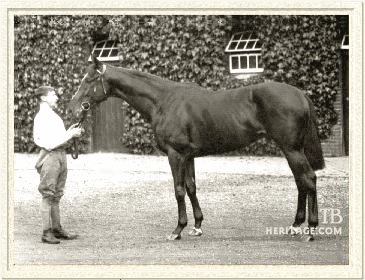 |
|
|
Bayardo was one of those rare versatile racehorses who was triumphantly tested for both speed and stamina, winning top races at distances from six furlongs to two and one-half miles. He is considered one of the greatest horses ever to grace the English turf, though he won only one classic race and was unplaced in two others. Although his untimely death at the age of eleven cut short his stud career, he led the sires list twice in England, and left a sire son who continued his line into the present.

Bayardo was bred by Alfred "Fairie" Cox, an Englishman who went to Australia as a young man and made a fortune when it was discovered that his property, a derelict sheep farm he had won as settlement for a poker debt on the voyage to Australia, was sitting on top of a large silver deposit. Several years later, Cox sold his shares in what had become known as the Broken Hill Silver Mines and returned to his native England to live a quiet, comfortable life. With his fortune, Cox indulged in his love of racehorses and began breeding his own runners. |
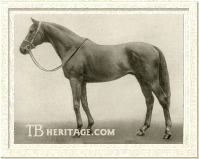
Bay Ronald
| |
Bayardo was sired by Bay Ronald, a good handicap performer sired by Hampton. Slow to come to hand as a younger horse, Bay Ronald eventually rounded into a decent sort, and during his career, he won the Hardwicke Stakes at Ascot and the 1 -1/4 mile City and Suburban Handicap. At stud, he was never considered to be a top class stallion, yet he came up with some very good stock. His daughter Rondeau was a stakes winner of nine races, including the Hardwicke Stakes and the Dullingham Plate, which she won twice. As a producer, she became the dam of internationally influential stallion Teddy. |
A son of Bay Ronald, Macdonald II, won the Prix Royal Oak in France, the French version of the English St. Leger, and became a good sire in France. Bay Ronald himself was sold and sent to France for the remainder of his brief stud career, leaving behind in England his young son Bayardo, who had not yet raced and another son, Dark Ronald, who was still in his mother's womb. Dark Ronald became a top class source of stamina through his son, Son-in-Law, and he also was capable of siring speed, as his daughter, Vaucluse, captured the One Thousand Guineas. Dark Ronald spent most of his stud career in Germany, where he was tremendously successful.
The female side of Bayardo's pedigree was replete with quality. His sixth dam was the great English filly, Blink Bonny, daughter of Melbourne and foundation mare Queen Mary. Bayardo's fifth dam was Borealis, a Newminster half-sister to Derby champion Blair Athol. This was the family of classic winners Caller Ou and Sir Bevys, and major stallions Bonnie Scotland and Hampton. An animal of Bayardo's quality was not an anomaly in this family.
|
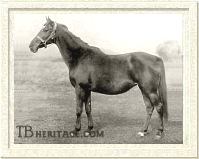
Galicia
| |
In 1897, Alfred Cox sent his Isonomy mare Isoletta to visit Galopin. The stallion was 25-years-old, but would be at the top of the English sire list the very next year at the age of 26. The result of the mating was Bayardo's dam, Galicia, a good racing filly, although she was hampered by injury.
Galicia won the Biennial Stakes at Ascot as a two-year-old, but then suffered a split pastern which compromised her the rest of her juvenile season. At three, she raced, but without the dash she had shown before her injury. In the Derby Cup, she was running well, but broke down, and that was the end of her racing career.
|
At stud, she gave Mr. Cox two classic winners, a classics-placed runner, and the dam of yet another classic winner. Galicia's son, Lemberg, a year younger than Bayardo, was sired by Cyllene and captured the Dewhurst Stakes and Middle Park Stakes at two, and the Derby, Eclipse Stakes, St. James Palace Stakes, the Jockey Club Stakes, and the Coronation Cup at age three. He also finished second in the Two Thousand Guineas and third in the St. Leger. His three-quarter brother, Kwang-su, by Cyllene's son Cicero, placed second in both the Two Thousand Guineas and the Derby. Silesia, Galicia's daughter by Spearmint, became the dam of the Beppo filly My Dear, winner of the Dewhurst Stakes, the Oaks, and the Champion Stakes. But Galicia's finest was undoubtedly Bayardo.
Bayardo on the Turf
Bayardo was a brown colt with lop ears, which he could not stand to have covered, and which he would move back and forth in rhythm with his stride. He had a mind of his own, and frequently liked to stand still and look off into the distance for long periods of time, even doing this before some of his races at Newmarket. Bayardo would also bang his chin on his feed manger, a habit his grooms referred to as "Bayardo's drum." He was a great favorite with the racing public, for both his brilliant speed and his ability to carry it classic distances and beyond. He was sent by Cox to the yard of veteran trainer Alec Taylor at Manton in Wiltshire. Bayardo soon showed he was something out of the ordinary when he easily beat a three-year-old and several other two-year-olds in a trial and was then set for his debut, in the New Stakes at the Royal Ascot meeting.
Under Bernard Dillon, Bayardo won this race with consummate ease and went on to enjoy an unbeaten juvenile season. Virtually every major race for two-year-olds fell to Mr. Cox's brilliant colt. For the rest of his career, he was partnered by jockey Danny Maher, and beginning with the National Breeders Produce Stakes, Bayardo went on to sweep the Richmond Stakes, the Buckenham Stakes, the Rous Memorial Stakes, the Middle Park Plate, and the Dewhurst Plate, in which he put on a masterful performance to defeat the highly-regarded Persimmon filly Perola, who would go on to capture the Oaks the next season.
There were not too many people who would have laid against Bayardo for the classics the next season, but Mother Nature had other ideas. The winter of 1908-1909 was an unusually severe one, with the cold and wind parching the ground. Many horses had their classic preparations compromised, Bayardo included. To complicate matters, Bayardo suffered a temporary bout of lameness after slipping on a frosty patch of ground one morning. All of this prompted Alec Taylor to try and dissuade Cox from running his colt in the Two Thousand Guineas. Cox wanted his horse to run, and was rewarded by seeing Bayardo finish a well-beaten fourth to King Edward VII's Cyllene colt, Minoru.
Following his poor performance at Newmarket, Bayardo began to find his best form and made steady improvement to the point that when Derby day rolled around, Minoru's trainer, Richard Marsh, commented, "He looked a different horse, and the sight of him really set my anxieties alight again." Unfortunately, the race for the Derby was marred: Sir Martin, the favorite, fell, impeding a number of runners, including Bayardo. Maher, on Bayardo, did not persevere with his mount and they crossed the wire in fifth place, while Minoru just scraped home by a head over Louviers to give King Edward VII his second victory in the Epsom classic.
After that afternoon at Epsom, Bayardo was virtually unbeatable, and did not suffer another defeat that season. Marsh recalled in his memoirs, "When once Alec Taylor got Bayardo right as a three-year-old, his excellence was undeniable. Fortunately for us that did not happen until after Minoru had won the Derby."
Bayardo's first win after the Derby was the Prince of Wales Stakes at the Royal Ascot meeting, followed by the Sandringham Foal Stakes at Sandown Park. He then took on a small, select field in the Eclipse Stakes at Sandown Park. The field included Royal Realm, who had won the Dullingham Plate, Santo Strato who had captured the Chester Cup, and Your Majesty, a son of Persimmon, who had captured the Eclipse Stakes and the St. Leger the previous season. Bayardo was kept by Maher along the rail, and simply galloped past his rivals to win by an easy two lengths. The 1-1/4 mile Duchess of York Plate at Hurst Park served as a final tune-up for Bayardo for the last of the classics, the St. Leger, and again he won easily.
It is not often that a horse who has finished unplaced in the first two classic races is favored over the colt who won those races, but that is exactly what happened when Bayardo and Minoru met in the St. Leger. The King's colt did not have the form he had possessed earlier in the spring, and finished a non-threatening fourth as Bayardo swept past Valens and Mirador to win with complete authority. Bayardo was none the worse for wear after his classic victory, and Taylor ran Cox's colt in the Doncaster Stakes only two days later, which Bayardo was never in danger of losing.
The rest of the season was a cakewalk for the dominating son of Bay Ronald. At Newmarket he breezed through a treble of the Champion Stakes, the Lowther Stakes, and the Limekiln Stakes, then back to Sandown for a victory in the Sandown Park Foal Stakes. His season finale was a victory in the Liverpool St. Leger. Since his losing effort in the Derby, Bayardo had reeled off eleven straight victories and went into winter quarters with sights on the major races for older horses the next season.
The main objective for Mr. Cox's champion at age four was the prestigious Ascot Gold Cup, a demanding 2-1/2 miles against the best competition in Britain and Europe. Two prep races fell to Bayardo before the Ascot event, the Biennial Stakes at Newmarket and the Chester Vase at Chester. In the latter race Bayardo gave a good scare to his backers by just getting up to win by a head. His jockey, Danny Maher, employed the same tactics with Bayardo in every race, which was to keep him well off the pace until nearly the end, and then making a sweeping run to the lead, a dangerous practice, but one which Maher was cockily confident that Bayardo could handle.
In the Gold Cup, Bayardo's most formidable opponent was the crack French runner, Sea Sick II, winner of the Prix du Jockey Club the previous season. Sea Sick II gave it a good try, and was running strongly in the lead with a mile and a quarter to go. Bayardo and Maher were biding their time farther back in the field. With six furlongs still to be run, Bayardo literally ran off with Maher and stormed up to the lead, sweeping by the gallant French colt, to win by an authoritative four lengths. This was widely regarded as the finest performance of Bayardo's magnificent career.
|
|
Bayardo's Race Record
|
| Year |
Age |
Starts |
1st |
2nd |
3rd |
Unplaced |
Amount in £ |
| 1908 |
2 |
7 |
7 |
0 |
0 |
0 |
£13,040 |
| 1909 |
3 |
13 |
11 |
0 |
0 |
2 |
£24,797 |
| 1910 |
4 |
5 |
4 |
1 |
0 |
0 |
£ 6,698 |
| Total |
-- |
25 |
22 |
1 |
0 |
2 |
£44,535 |
| | A win a short time later, in the Dullingham Plate, was not so brilliant but it set him up nicely for his turf finale in the Goodwood Cup. It was also his fifteenth win in succession, dating back to his disappointing run in the Derby the previous spring. He had shown he could win at any distance, from 5 furlongs to two and one-half miles, one of the few racehorses ever to be so thoroughly and successfully tried for both speed and stamina.
|
|
Bayardo's swan song was a major disappointment. There weren't many people, certainly not owner Alfred Cox, trainer Alec Taylor, jockey Danny Maher, or Bayardo's legions of fans, who thought he would have any trouble of disposing of an unheralded three-year-old named Magic in the Goodwood Cup, even though he was spotting the younger colt a staggering 36 pounds. But the unthinkable happened--Bayardo went down to defeat and the blame lay squarely on the shoulders of his rider, Danny Maher. In an uncharacteristically ill-judged ride, Maher kept his mount under a tight hold in the early running, allowing Magic to set a leisurely gallop. When Maher finally let Bayardo have his head, he had so much ground to make up, that Bayardo missed by a neck in trying to notch his sixteenth straight victory. Alec Taylor was livid at the jockey's ride on Bayardo, and was not reticent about leveling criticism: "Maher let Magic get a furlong in front and never attempted to close the gap until reaching the comparatively short straight--and he was giving away all that weight, too." The Goodwood Cup was Magic's only major victory.
Bayardo in the Stud
Bayardo was then retired to stand at Alec Taylor's Manton Stud in Wiltshire, where after only a few years, his stud fee rose to 300 guineas. Bayardo had won 22 of 25 races, and was immediately a popular stallion prospect upon his retirement to the Manton paddocks. He was leading sire in Britain in 1917 and 1918 and leading sire of broodmares in 1925. He sired three classic winners, and two of them won England's Triple Crown during the years of World War I.
Gay Crusader
The first of Bayardo's classic winners was GAY CRUSADER (1914), out of Gay Laura, by Beppo. Like his sire, Gay Crusader was bred and owned by Cox, and trained by Alec Taylor at Manton. Gay Crusader was a light-framed bay with a doubtful temperament, which grew increasingly more difficult as he got older. He had only two starts as a two-year-old, the Clearwell Stakes and the Criterion Stakes. He was unplaced in the former and won the latter.
As a three-year-old, Gay Crusader very nearly did not have a classic season, as the government tried to ban racing. Gay Crusader had won the Two Thousand Guineas without any bother, but then came the battle about whether to keep racing going during the war. The position of the government was that racehorses consumed large quantities of feed that could be put to better use with the food shortages Britain was suffering. The Jockey Club and the Thoroughbred Breeders' Association thought differently for two reasons. First, public morale. It was thought wise to keep some form of public entertainment going for the populace. Second, racing was needed to weed out the superior breeding prospects for the future. The Board of Trade agreed, and allowed racing to be run at a restricted level, and conducted at Newmarket. Consequently, the Derby was not run until July, and at Newmarket, rather than Epsom. Gay Crusader won over a decent field including Dark Legend and Diademe, winner of the One Thousand Guineas.
The war-time substitute St. Leger was run at Newmarket as the September Stakes, and Gay Crusader won easily, and then added the Newmarket Gold Cup, the Champion Stakes, the Lowther Stakes, and the Limekiln Stakes, all at Newmarket.
|
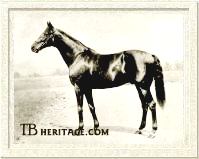
Gay Crusader, probably as good as his sire on the turf.
| |
Gay Crusader was kept in training as a four-year-old, but a tendon injury forced his retirement to Manton Stud, where it was hoped he would pick up the mantle left by his sire, who had died the previous spring. Gay Crusader was not a success as a stallion. His best offspring were probably Hurstwood, winner of the Newmarket Stakes and the Hardwicke Stakes and third in the Derby; Hot Knight, winner of the Limekiln Stakes and second in the Derby and St. Leger; and Medieval Knight, winner of the Coventry Stakes and the Middle Park Stakes. |
Gay Crusader enjoyed a bit more success with his daughters, and three of them were of major significance as broodmares. Indolence, out of Barrier, by Grey Leg, became the dam of Belgian champion Prince Rose, a horse who proved he belonged on the world stage by placing in the Prix de l'Arc de Triomphe at Longchamps and winning the Prix du President de la Republique. Prince Rose went on to sire three internationally influential sons: Princequillo, Prince Bio, and Prince Chevalier.
Gay Camp, out of Parasol, by Sunstar, wound up in Italy as a member of the broodmare band of Italian breeder Federico Tesio. For him, she produced Ettore Tito, by Fairway, a champion three-year-old colt in Italy, as well as El Greco, by Pharos. El Greco was also a champion, capturing the Italian St. Leger. At stud, he sired Romanella, a champion two-year-old filly in Italy and dam of the unbeaten champion and major sire Ribot.
The third daughter of Gay Crusader to make a name for herself was Loika, dam of Djebel. By Tourbillon, Djebel was a champion in France and England. He won the English Two Thousand Guineas and the Prix de l'Arc de Triomphe among other races, and became a very influential stallion.
It is interesting to note that the second dam of Gay Crusader was a Galopin mare, Galeottia, a winner of the One Thousand Guineas. Bayardo himself was out of a Galopin daughter, and his sire, Bay Ronald, was out of a daughter of Galliard, a son of Galopin. Thus, both Bayardo and Gay Crusader were inbred to Galopin. Whether this accounted for some of the racing ability of these two horses is a matter of conjecture, but it is a fact that Alec Taylor, who trained both colts, could not really separate the two based on their ability. Taylor later said: "He [Gay Crusader] was equally brilliant whether at five furlongs or two miles; in fact I really don't know how good he was. It was just a disaster that I was not able to train him as a four-year-old and prove it to the world." Gay Crusader died in 1932 at the age of 18.
Gainsborough
Gainsborough (1915) was the second of Bayardo's Triple Crown-winning sons. Bred by Lady James Douglas, Gainsborough, named for an English town Lady Douglas picked out of a railway guide, possessed a truly classic pedigree. His dam was Rosedrop, a victress in the Oaks, and her sire, St. Frusquin, was a classic-winning son of St. Simon. Lady Douglas bred her horses to sell at the sales, and consequently Gainsborough was sent to the Newmarket sales with a reserve of 2,000 guineas . It was not surprising that the colt failed to make this lofty reserve, given that World War I was still raging across the Channel. Lady Douglas took him home, and decided to keep him to race in her colors, turning down a private offer of 1,800 guineas for the colt. He was sent to the yard of Colledge Leader at Newmarket, but Leader joined the armed forces soon after, and Lady Douglas then enlisted Alec Taylor to train her colt. Gainsborough joined the Manton yard in Wiltshire, where one of his stablemates was Gay Crusader.
It can be said thatGainsborough, good a racehorse as he was, was not quite so good as Gay Crusader, but he enjoyed the more brilliant stud career. Gainsborough was a very athletic bay colt, closely resembling his sire. Gainsborough also inherited his sire's willing temperament and intelligence. He started but three times as a juvenile, all at Newmarket. He was fourth and third in two tiny races and then won the six furlong Autumn Stakes.
|
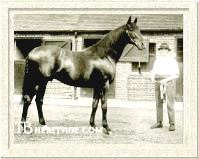
Gainsborough, another war-time Triple Crown winner and influential sire.
| |
As a three-year-old, Gainsborough ran unplaced in a sprint race won by Sicyon. But this was merely a tightener for the Two Thousand Guineas, which he won easily by a length and a half, thereby enabling Lady Douglas to become the first woman to not only breed a classic winner, but to have that horse run in her own silks. Joe Childs, Gainsborough's regular rider, was attached to the 4th Hussars, and he donated his winnings to his regiment. |
In the Derby, again run at Newmarket, Gainsborough won easily from his stablemate Blink and twelve others. An added bonus for the Manton stable was the victory of the aforementioned My Dear in the Oaks two days after the Derby.
A victory against older horses in the Newmarket Gold Cup, at a distance of two miles and 24 yards, set Gainsborough up for his sternest test, the September Stakes, the wartime version of the St. Leger still being run at Newmarket. The field was a strong one, including One Thousand Guineas winner Ferry, Oaks victress My Dear, Prince Chimay, and Zinovia. Gainsborough won by a commanding three lengths from My Dear, and Prince Chimay was third, four lengths farther back. Alec Taylor was the trainer for all three of these horses.
Much like his sire had, Gainsborough ended his turf career on a note of anti-climax. In the Jockey Club Stakes at Newmarket, he was beaten by Prince Chimay by a length, without excuse. A son of Chaucer, Prince Chimay was a decent horse in his own right, and at stud, carved a niche in breeding history for himself as the sire of Vatout and grandsire of Bois Roussel.
Following this loss, Gainsborough was retired to his owner's new stud at Harwood, near Newbury. Gainsborough succeded where Gay Crusader had failed, becoming champion sire in 1932 and 1933, second in 1931, third in 1930 and 1935, and fourth in 1925, 1926, and 1927. Among his best progeny were: Hyperion, winner of the Derby and St. Leger and champion sire six years in succession; Orwell, winner of the Two Thousand Guineas; Singapore, winner of the St. Leger; Solario, winner of the St. Leger and Ascot Gold Cup and later an influential sire.
Daughters of Gainsborough made admirable broodmares. Cameronian, winner of the Two Thousand Guineas and Derby, was produced from Gainsborough's daughter Una Cameron. Gainsborough Lass, winner of the Coronation Stakes and third in the One Thousand Guineas became dam of the good filly Glass Slipper. Another Gainsborough daughter, Mah Mahal, out of Mumtaz Mahal, became the dam of Derby winner Mahmoud and his half-sister by Bahram, Mah Iran, who became the dam of Eclipse Stakes champion Migoli. Gainsborough died at the age of thirty in 1945.
Bayuda
Bayardo had one other classic winner, the filly Bayuda, also bred by Lady James Douglas and trained by Alec Taylor at Manton. Out of the Eager mare Jessica, this was the family of Rosicrucian and The Palmer. Bayuda started only three times as a juvenile, running unplaced and then third in her first two starts. She then broke her maiden in the Cheveley Park Stakes, defeating several nice fillies, including Lord Derby's Swynford filly, Beresina. |
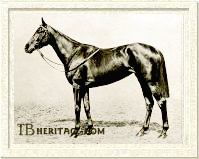
Bayuda
| |
Bayuda did not start again until the One Thousand Guineas, where she was fourth to Roseway. Bayuda turned the tables on Roseway in the Oaks, and under Joe Childs, won from Roseway by a length and a half. Then came perhaps her bravest performance, in the St. George Stakes at Liverpool. Bayuda was set to concede 21 pounds to Lord Derby's Bayardo filly Rothesay Bay, a half-sister to Scapa Flow. The race was a thriller between the two Bayardo fillies, and at the end, Bayuda lost by only a head. Alec Taylor hoped this strong performance would set his prize filly up perfectly for the St. Leger, but she suffered a career-ending injury shortly beforehand and was retired to Harwood. |
In the stud Bayuda produced a filly by Hurry On that the Aga Khan purchased for 4,000 guineas and named Hajibibi. That was all. There were no more foals from Bayuda. The mare had a difficult delivery and suffered internal injuries that rendered her barren. After a few failed attempts to get her in foal, she was given by Lady Douglas to a Mr. Gerald Deane to use as a pleasure horse. Deane toyed with the idea of returning her to training, and Lady Douglas gave her permission for this venture. Bayuda was galloped but never did return to the races. It was a sad end for this classic-winning filly.
Other Bayardo Offspring
Bayardo had several other high class runners, including: Manilardo, a full brother to Gay Crusader which captured the Coronation Cup; Manton, out of the Le Sancy mare Jane Grey, placed third in the St. Leger and ran well in some other races, including the St. George Stakes at Liverpool; he was sent to Poland in 1922, and in the late 1920s was one of the top three leading sires there, including champion sire in 1930. Mapledurham, out of Montem, by Ladas, placed third to Bayuda in the Cheveley Park Stakes and third to her in the Oaks; Allenby, out of Derby-winning filly Tagalie, placed second in the Two Thousand Guineas; and Pompadour, out of Popinjay by St. Frusquin, placed third in the One Thousand Guineas. |
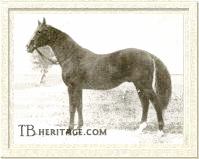
Son Manton was a leading sire in Poland.
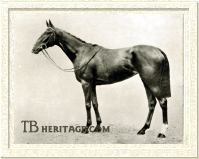
Grandaughter Saucy Sue sent Bayardo to the top of the Broodmare sire list.
| |
Bayardo was champion sire of broodmares in 1925, largely through the successes of Lord Astor's Swynford filly, Saucy Sue (1922). Out of Bayardo's daughter Good and Gay, a full sister to Pompadour, Saucy Sue captured the One Thousand Guineas, the Oaks, and the Coronation Stakes, and was also third in the Park Hill Stakes. Her half brother, Swift and Sure (1923), by Swynford, won the Chester Vase and four other races at age three, and later became a useful sire.
It is interesting to note that Bayardo and members of his female family seemed to have an affinity for the blood of the Marco stallion Beppo. Gay Crusader and his brother Manilardo were out of a Beppo mare, Oaks winner My Dear, as has been mentioned, was sired by Beppo and out of a half sister to Bayardo, and the short-lived Picaroon, winner of the Middle Park Stakes and the Champion Stakes, was by Beppo out of Ciceronnetta, a Cicero half-sister to My Dear.
It was a tragedy for the British breeding industry that Bayardo died in the prime of life. At the age of eleven, he became ill with thrombosis, which paralyzed his hind legs. He died soon after. |
Bayardo was able to leave one son that kept his sire line alive and flourishing. Through Gainsborough, and Gainsborough's son, Hyperion, have come the likes of Aureole, Heliopolis, Alibhai, Khaled, Swaps, Star Kingdom, Noholme II, Nodouble, Helios, Ruthless, Deimos, Aristophanes, Forli, as well as Gulf Stream, a major sire in Argentina and Aldis Lamp, twelve-time champion sire in Belgium. What Bayardo would have accomplished had he been blessed with a longer life is one of the great "what ifs" of thoroughbred breeding.
--Elizabeth Martiniak
|
|
|
|

